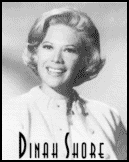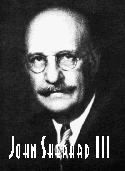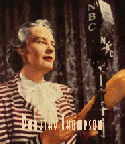RADIO IN 1939
by
Donna L. Halper
Broadcast Historian/Emerson College
 The final year of the 1930s was still part of the "Golden Age of Radio." According to Radio Today magazine, there were now 44 million radios in use in the United States. As for the talent scene, critics were singing the praises of an up and coming vocalist named Dinah Shore. A new male vocalist named Dennis Day was doing quite well on the Jack Benny show on NBC. And speaking of NBC, perhaps you recall Fred Waring and his orchestra, which joined that network in 1939, sponsored by Chesterfield. Perhaps you had your copy of White's Radio Log handy, so that you could check out the call letters and frequencies of distant stations-- late night dx'ing was a popular hobby for radio fans. As for radios, perhaps you owned an Emerson portable (you could get a nice 5-tube superheterodyne for only $19.95)-- and the popular battery portables continued to get smaller and lighter: Majestic offered one that only weighed four pounds!
The final year of the 1930s was still part of the "Golden Age of Radio." According to Radio Today magazine, there were now 44 million radios in use in the United States. As for the talent scene, critics were singing the praises of an up and coming vocalist named Dinah Shore. A new male vocalist named Dennis Day was doing quite well on the Jack Benny show on NBC. And speaking of NBC, perhaps you recall Fred Waring and his orchestra, which joined that network in 1939, sponsored by Chesterfield. Perhaps you had your copy of White's Radio Log handy, so that you could check out the call letters and frequencies of distant stations-- late night dx'ing was a popular hobby for radio fans. As for radios, perhaps you owned an Emerson portable (you could get a nice 5-tube superheterodyne for only $19.95)-- and the popular battery portables continued to get smaller and lighter: Majestic offered one that only weighed four pounds!
 There were plenty of radio dramas and soap operas on the air-- you were enjoying Ezra Stone in The Aldrich Family on NBC-Blue, while The Guiding Light was on NBC-Red, as were Phil Spitalny's All-Girl Orchestra starring in the Hour of Charm. Life Can be Beautiful was on CBS, and The Lone Ranger was on the Mutual Network. Also, 1939 was a significant year for FM-- in late May, Yankee network owner John Shepard III teamed up with inventor Edwin Howard Armstrong to bring the new technology to New England-- W1XOJ was the first FM station in Massachusetts, soon to be followed by W1XER in New Hampshire.
There were plenty of radio dramas and soap operas on the air-- you were enjoying Ezra Stone in The Aldrich Family on NBC-Blue, while The Guiding Light was on NBC-Red, as were Phil Spitalny's All-Girl Orchestra starring in the Hour of Charm. Life Can be Beautiful was on CBS, and The Lone Ranger was on the Mutual Network. Also, 1939 was a significant year for FM-- in late May, Yankee network owner John Shepard III teamed up with inventor Edwin Howard Armstrong to bring the new technology to New England-- W1XOJ was the first FM station in Massachusetts, soon to be followed by W1XER in New Hampshire.
 If you were alive in 1939, you know what a great year for entertainment it was-- undoubtedly, you went to New York for the opening of the World's Fair. RCA's David Sarnoff was there, announcing that television was here to stay, and demonstrating his company's first TV station, W2XBS-- soon to be known as WNBT. And that was one of many amazing events; your 75 cents admission transported you to the "World of Tomorrow", with its vision of a future without crime or unemployment or litter, where cars that looked a bit like space ships sped along the superhighways which joined even the most distant cities. In the World of Tomorrow, every home was filled with labour-saving devices to make housework easier, and the ultimate in servants was a robot named Electro. Over 40 million people would visit the Fair before it ended, including such luminaries as President Roosevelt, the King and Queen of England and Albert Einstein.
If you were alive in 1939, you know what a great year for entertainment it was-- undoubtedly, you went to New York for the opening of the World's Fair. RCA's David Sarnoff was there, announcing that television was here to stay, and demonstrating his company's first TV station, W2XBS-- soon to be known as WNBT. And that was one of many amazing events; your 75 cents admission transported you to the "World of Tomorrow", with its vision of a future without crime or unemployment or litter, where cars that looked a bit like space ships sped along the superhighways which joined even the most distant cities. In the World of Tomorrow, every home was filled with labour-saving devices to make housework easier, and the ultimate in servants was a robot named Electro. Over 40 million people would visit the Fair before it ended, including such luminaries as President Roosevelt, the King and Queen of England and Albert Einstein.
Having endured so much suffering during the Depression, the country was eager for a hopeful vision of the future. Perhaps that is why the movie "The Wizard of Oz" touched so many hearts, along with Judy Garland's beautiful song, "Over the Rainbow". And another big movie in 1939 was the somewhat controversial "Gone With the Wind"-- to us today, the idea that the word "damn" would cause any consternation seems odd, but in the 1930s, there was a very strict code of conduct for all movies, and it included a list of 'banned words', the presence of which could cause a director problems. Luckily, "Gone With the Wind" managed to avoid being censored, Rhett did in fact say "Frankly, my dear, I don't give a damn", and audiences didn't seem especially shocked. The movie was a huge success and it went on to win the Academy Award for Best Picture, with Vivian Leigh also winning Best Actress.
1939 was a good year for new inventions-- DDT, for example, and a wonderful new fabric called "nylon". Pan American began commercial flights across the Atlantic in 1939, and for those who preferred to drive, the first cars with an automatic clutch were available. A loaf of bread cost 8 cents, and you could get a new car for $700; the average person made $1,729 a year.
Some of the music in 1939 was patriotic-- Kate Smith was constantly asked to sing "God Bless America" on her radio show-- but other songs were just silly and fun-- "Beer Barrel Polka" was a big hit in 1939, as was "Three Little Fishes". And a new trend was developping: several radio stations now featured personable announcers who played records and talked to the audience. Among the most popular of these new "disc jockeys" was New York's Martin Block with his popular show The Make-Believe Ballroom. In Chicago, the first African-American disc jockey, Jack Cooper, had been on the air throughout the 1930s, and he still was playing the hits in 1939. Although radio stations in 1939 had few black announcers, more and more songs by black performers were being heard on a regular basis-- Duke Ellington's Orchestra was especially popular, as was female vocalist extraordinaire Ella Fitzgerald. And while most major pro sports were still segregated, boxing was not; one athlete who kept right on winning was Joe Louis, whose matches were always heard on radio. In an interesting news note, one of the country's largest and most respected black newspapers, the Pittsburgh Courier, had already sent a reporter to Europe to cover the growing tension there-- and since he spoke French, he was able to scoop several of his white colleagues when hostilities broke out in France...
As for America's most famous woman, the First Lady, Eleanor Roosevelt was a frequent guest on the networks-- she gave several talks in 1939, including one around Mother's Day about the contributions women made to the founding of the United States.  Women's shows (cooking, homemaking, fashion, etc) were still a fixture of many stations, but several stations also had women news announcers and even a woman commentator or two. Probably the best known was former newspaper columnist Dorothy Thompson, who became the NBC network's first woman correspondent-- she even made the cover of Time Magazine for being one of the few network newswomen.
Women's shows (cooking, homemaking, fashion, etc) were still a fixture of many stations, but several stations also had women news announcers and even a woman commentator or two. Probably the best known was former newspaper columnist Dorothy Thompson, who became the NBC network's first woman correspondent-- she even made the cover of Time Magazine for being one of the few network newswomen.
Americans in 1939 didn't want to think about a war in Europe; most preferred to stay neutral. But reporters like H.V. Kaltenborn and Edward R. Murrow knew what was happening and tried to keep the listeners informed. It was a very ambivalent time in America-- while many people were outraged by what Hitler was doing, in New York, 22,000 pro-Nazi sympathisers held a large and noisy rally. Meanwhile, in Canada, the government banned Father Coughlin's newspaper Social Justice for being excessively racist and prejudiced, but in the USA, he was still on a large number of stations and still causing controversy. When Germany was invading Poland and Czechoslovakia, all the major radio networks sent reporters to do live coverage . President Roosevelt was still insisting the United States would stay out of the war, and most of us had no reason to doubt him. He remained a very popular president, and his Fireside Chats
. President Roosevelt was still insisting the United States would stay out of the war, and most of us had no reason to doubt him. He remained a very popular president, and his Fireside Chats were an essential element of how he reached out to the average person. FDR had been doing these talks since 1933, but even six years later, people still looked forward to them. Few Americans could foresee that we would be unable to remain outside the hostilities indefinitely. As 1939 ended, radio was still king, dance bands were still the rage, and the future looked reasonably bright. A large part of the decade had been very difficult for many Americans, but now it seemed things were continuing to improve.
were an essential element of how he reached out to the average person. FDR had been doing these talks since 1933, but even six years later, people still looked forward to them. Few Americans could foresee that we would be unable to remain outside the hostilities indefinitely. As 1939 ended, radio was still king, dance bands were still the rage, and the future looked reasonably bright. A large part of the decade had been very difficult for many Americans, but now it seemed things were continuing to improve.
 The final year of the 1930s was still part of the "Golden Age of Radio." According to Radio Today magazine, there were now 44 million radios in use in the United States. As for the talent scene, critics were singing the praises of an up and coming vocalist named Dinah Shore. A new male vocalist named Dennis Day was doing quite well on the Jack Benny show on NBC. And speaking of NBC, perhaps you recall Fred Waring and his orchestra, which joined that network in 1939, sponsored by Chesterfield. Perhaps you had your copy of White's Radio Log handy, so that you could check out the call letters and frequencies of distant stations-- late night dx'ing was a popular hobby for radio fans. As for radios, perhaps you owned an Emerson portable (you could get a nice 5-tube superheterodyne for only $19.95)-- and the popular battery portables continued to get smaller and lighter: Majestic offered one that only weighed four pounds!
The final year of the 1930s was still part of the "Golden Age of Radio." According to Radio Today magazine, there were now 44 million radios in use in the United States. As for the talent scene, critics were singing the praises of an up and coming vocalist named Dinah Shore. A new male vocalist named Dennis Day was doing quite well on the Jack Benny show on NBC. And speaking of NBC, perhaps you recall Fred Waring and his orchestra, which joined that network in 1939, sponsored by Chesterfield. Perhaps you had your copy of White's Radio Log handy, so that you could check out the call letters and frequencies of distant stations-- late night dx'ing was a popular hobby for radio fans. As for radios, perhaps you owned an Emerson portable (you could get a nice 5-tube superheterodyne for only $19.95)-- and the popular battery portables continued to get smaller and lighter: Majestic offered one that only weighed four pounds! There were plenty of radio dramas and soap operas on the air-- you were enjoying Ezra Stone in The Aldrich Family on NBC-Blue, while The Guiding Light was on NBC-Red, as were Phil Spitalny's All-Girl Orchestra starring in the Hour of Charm. Life Can be Beautiful was on CBS, and The Lone Ranger was on the Mutual Network. Also, 1939 was a significant year for FM-- in late May, Yankee network owner John Shepard III teamed up with inventor Edwin Howard Armstrong to bring the new technology to New England-- W1XOJ was the first FM station in Massachusetts, soon to be followed by W1XER in New Hampshire.
There were plenty of radio dramas and soap operas on the air-- you were enjoying Ezra Stone in The Aldrich Family on NBC-Blue, while The Guiding Light was on NBC-Red, as were Phil Spitalny's All-Girl Orchestra starring in the Hour of Charm. Life Can be Beautiful was on CBS, and The Lone Ranger was on the Mutual Network. Also, 1939 was a significant year for FM-- in late May, Yankee network owner John Shepard III teamed up with inventor Edwin Howard Armstrong to bring the new technology to New England-- W1XOJ was the first FM station in Massachusetts, soon to be followed by W1XER in New Hampshire. If you were alive in 1939, you know what a great year for entertainment it was-- undoubtedly, you went to New York for the opening of the World's Fair. RCA's David Sarnoff was there, announcing that television was here to stay, and demonstrating his company's first TV station, W2XBS-- soon to be known as WNBT. And that was one of many amazing events; your 75 cents admission transported you to the "World of Tomorrow", with its vision of a future without crime or unemployment or litter, where cars that looked a bit like space ships sped along the superhighways which joined even the most distant cities. In the World of Tomorrow, every home was filled with labour-saving devices to make housework easier, and the ultimate in servants was a robot named Electro. Over 40 million people would visit the Fair before it ended, including such luminaries as President Roosevelt, the King and Queen of England and Albert Einstein.
If you were alive in 1939, you know what a great year for entertainment it was-- undoubtedly, you went to New York for the opening of the World's Fair. RCA's David Sarnoff was there, announcing that television was here to stay, and demonstrating his company's first TV station, W2XBS-- soon to be known as WNBT. And that was one of many amazing events; your 75 cents admission transported you to the "World of Tomorrow", with its vision of a future without crime or unemployment or litter, where cars that looked a bit like space ships sped along the superhighways which joined even the most distant cities. In the World of Tomorrow, every home was filled with labour-saving devices to make housework easier, and the ultimate in servants was a robot named Electro. Over 40 million people would visit the Fair before it ended, including such luminaries as President Roosevelt, the King and Queen of England and Albert Einstein. Women's shows (cooking, homemaking, fashion, etc) were still a fixture of many stations, but several stations also had women news announcers and even a woman commentator or two. Probably the best known was former newspaper columnist Dorothy Thompson, who became the NBC network's first woman correspondent-- she even made the cover of Time Magazine for being one of the few network newswomen.
Women's shows (cooking, homemaking, fashion, etc) were still a fixture of many stations, but several stations also had women news announcers and even a woman commentator or two. Probably the best known was former newspaper columnist Dorothy Thompson, who became the NBC network's first woman correspondent-- she even made the cover of Time Magazine for being one of the few network newswomen.